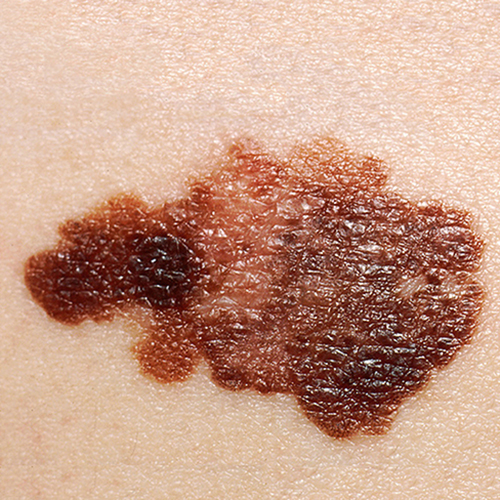
Researchers at the Salk Institute have uncovered a “genetic switch,” involving CRTC3, that seems to play a key role in the development of melanoma, and which could be a new target for drug developers. BRAF inhibitors are sometimes effectives against melanoma, but relapse and treatment resistance rates are high. This new finding could help point to ways of solving that problem or completely new treatments.
The study was published this week in in the journal Cell Reports.
“We’ve been able to correlate the activity of this genetic switch to melanin production and cancer,” says Salk study corresponding author Marc Montminy, M.D., Ph.D., a professor in the Clayton Foundation Laboratories for Peptide Biology.
Melanoma is one of the deadliest types of skin cancer, even though it accounts for only about 1 percent of such malignancies. People with light skin and poor ability to tan are at highest risk for the disease. CRTC3 upregulation has been associated with higher mortality from melanoma.
This cancer develops when pigment-producing cells, called melanocytes, mutate and begin to multiply uncontrollably. These mutations can cause proteins, like CRTC3, to prompt the cell to make an abnormal amount of pigment or to migrate and be more invasive.
Researchers have known that the CRTC family of proteins (CRTC1, CRTC2, and CRTC3) is involved in pigmentation and melanoma, yet few details have been worked out. “This is a really interesting situation where different behaviors of these proteins, or genetic switches, can actually give us specificity when we start thinking about therapies down the road,” says first author Jelena Ostojic, a former Salk staff scientist and now a principal scientist at DermTech.
By profiling transcriptomes of CRTC3-depleted murine and human melanoma cells, the researchers found that eliminating CRTC3 in mice caused a color change in the animal’s coat color, demonstrating that the protein is needed for melanin production. Deleting CRTC2 or CRTC3 did not have the same affect. Their experiments also revealed that when the protein was absent in melanoma cells, the cells migrated and invaded less, meaning they were less aggressive.
The team characterized, for the first time, the connection between two cellular communications (signaling) systems that converge on the CRTC3 protein in melanocytes. These two systems tell the cell to either proliferate or make the pigment melanin. Montminy likens this process to a relay race. Essentially, a baton (chemical message) is passed from one protein to another until it reaches the CRTC3 switch, either turning it on or off.
“The fact that CRTC3 was an integration site for two signaling pathways–the relay race–was most surprising,” says Montminy, who holds the J.W. Kieckhefer Foundation Chair. “CRTC3 makes a point of contact between them that increases specificity of the signal.”
Next, the team plans to further investigate the mechanism of how CTRC3 impacts the balance of melanocyte differentiation to develop a better understanding of its role in cancer.
The researchers point out that it is known that the MAPK pathway is commonly hyperactivated in melanomas because of mutations in RAS and BRAF that lead to downstream induction of the Ser/Thr kinases ERK1/2. As noted earlier, while BRAF inhibitors are sometimes effective in melanoma treatment, resistance and relapse are also high. This suggests involvement of other signaling pathways that can circumvent BRAF inhibition. The CREB pathway is one that reportedly confers resistance to BRAF blockers.
The researchers write that “Our results suggest that CRTC3 has a therapeutic benefit in the treatment of pigmentary disorders, cutaneous melanoma, and potentially other conditions characterized by dysregulated cAMP/MAPK crosstalk.”












